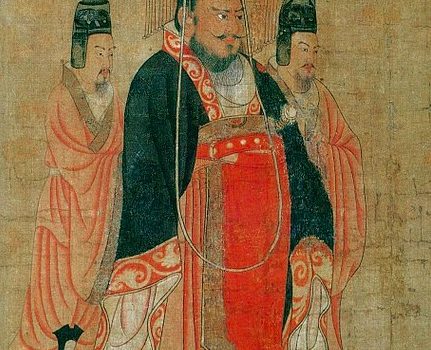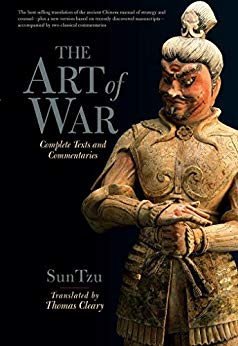

This article is an excerpt from the Shortform summary of "The Art of War" by Sun Tzu. Shortform has the world's best summaries of books you should be reading.
Like this article? Sign up for a free trial here .
Who was General Cao Cao? What lessons can we learn from China’s General Cao Cao? How did he follow the principles of Sun Tzu’s The Art of War to lead his forces to victory?
General Cao Cao was a well-respected and renowned military leader in Chinese history who avidly abided by Sun Tzu’s Art of War. Toward the end of the Han dynasty (206 B.C.E. to 220 C.E.), Cao Cao often invaded enemy territories.
We’ll cover three lessons you can learn from General Cao Cao and how he adapted Sun Tzu’s strategies to become a great leader.
General Cao Cao and Rewards
As discussed, toward the end of the Han dynasty (206 B.C.E. to 220 C.E.), General Cao Cao often invaded enemy territories. During these raids, he would acquire a trove of valuable treasures, whether rare objects or gold. Whenever these spoils were retrieved, he would divvy them out to those who showed incredible strength and effort. He was generous with his rewards. Those who did not show exceptional prowess or effort received nothing. In this way, his soldiers were motivated to work hard, and he was able to be successful in most of his battles.
Lesson #1: Manage Your Force Thoughtfully
You should gather your troops only after an assessment of yourself and your enemy has been made and victory is determined the likely outcome. If you gather troops too soon and have to redo the action down the line when you really need them, the public will be weary and less supportive.
However, gathering the troops is not all that is required to build a strong and successful force. Ensuring that the troops are rewarded for their efforts, as General Cao Cao did, will breed motivation.
- Rewards should be intentional and earned.
- They should be delivered without bias of rank.
Rewards given smartly will encourage the troops to behave in a manner that reaps rewards. On the other hand, rewarding everyone equally or arbitrarily will generate no motivation and deplete your resources.
Likewise, punishments are just as useful as rewards in building the constitution of your force.
General Cao Cao and the Suspicious Surrender
When one of General Cao Cao’s rivals surrendered to him, Cao Cao allowed the rival to return home. Shortly after, the rival returned to attack General Cao Cao and killed Cao Cao’s son and nephew. General Cao Cao also suffered an arrow injury.
The rival returned again with an armed force, but General Cao Cao was successful in defending against them. On reflection, Cao Cao blamed his benevolence and negligence in letting the rival go for the fate of his family and army, advising his commanders to never make such an egregious error.
Lesson #2: Learn to Read Your Enemy
General Cao Cao paid for his misjudgment. Learn to read your enemy to make sound judgments in battle. Some signs to look for:
Signs of Manipulation
- If an enemy negotiator comes speaking of peace but carries no treaty, be wary. The enemy may be stalling to manage some issue with their troops or distract you from an ensuing attack.
- If the enemy divides its power and sends half to attack while the other half retreats, they are trying to manipulate you to chase them.
- If the enemy becomes aggressive but does not attack, be ready for an ambush. They are trying to distract you.
Signs of Enemy Advantage
- Be mindful of your opponent’s positioning. If they leave from a strong position and move to another, there must be some advantage to them doing so.
- If the enemy orchestrates a mass of forces, expect their reinforcements to follow shortly.
- If the enemy depletes their food supplies and abandons essential cooking tools, they are at the end of their rope. The troops now have nothing to lose and will fight to the death.
General Cao Cao and Alliances
During the Three Kingdoms Era, the Shu army surrounded a faction of the Wei military. General Cao Cao, a Wei general, wanted to relocate the rest of the Wei’s capital away from enemy lines for safety. But a minister of Wei advised against such an action, stating that it exuded weakness. Instead, he said they should form an alliance with the state of Wu. The Shu and Wu were considered to be allies, but the minister knew this was only a surface appearance. He assumed the Wu leadership would begrudge the Shu gains.
General Cao Cao agreed and sent an emissary to create an alliance with Wu, who was tasked with attacking the Shu from the back. The Wu were successful, and the Shu retreated from its position surrounding the Wei army.
Lesson #3: Take Advantages of Opportunities for Alliance
- Form alliances to increase your strength to a point where fighting would be ill-advised for your opponent.
- Form alliances with the enemy’s allies to disrupt the enemy’s power.
General Cao Cao was an eminent general. Learn from his successes (and failures) to find victory in your own battles.
———End of Preview———

Like what you just read? Read the rest of the world's best summary of "The Art of War" at Shortform . Learn the book's critical concepts in 20 minutes or less .
Here's what you'll find in our full The Art of War summary :
- How to mislead your enemies to win the war
- Classic examples from Chinese history to illustrate Sun Tzu's strategies
- How to use spies to gather information and defeat your opponents






